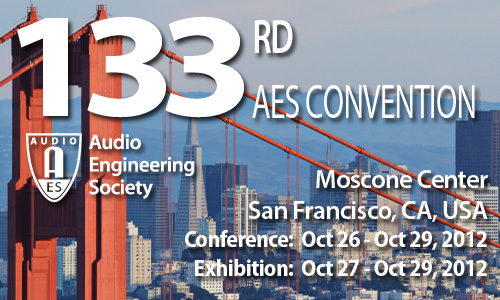
AES San Francisco 2012
Engineering Brief EB4
EB4 - eBrief Presentations—Lectures 2
Monday, October 29, 2:00 pm — 3:15 pm (Room 121)
Chair:
Tad Rollow
EB4-1 Parametric Horn Design—Ambrose Thompson, Martin Audio - High Wycombe, UK
The principle barrier to more widespread use of numerical techniques for horn design is not a shortage of advanced computational libraries, rather the difficultly in defining the problem to solve in a suitable format. The traditional approach of creating horn geometry in large commercial CAD programs then exporting, meshing, assigning conditions, solving, and inspecting results denies the engineer the ability to easily iterate the design. We introduce an object-orientated parametric description of a horn that enables the engineer to modify meaningful parameters to generate geometry of appropriate complexity. The entire process is performed in one environment and an early implementation has been shown to allow nearly 100 iterations of one horn in one week. Results for this and another multi-driver HF horn are given.
Engineering Brief 72 (Download now)
EB4-2 Integration of Touch Pressure and Position Sensing with Speaker Diaphragms—Adrian Freed, University of California, Berkeley - Berkeley, CA, USA
Speaker cones and other driver diaphragms are usually too fragile to be good sites for touch interaction. This can be solved by employing new, lightweight piezoresistive e-textiles with flat, rectangular, stiff surfaces used in full-range drivers from HiWave. Good low-frequency performance of piezoresistive fabric has an advantage over piezoelectric sensing for this situation. Applications of these integrated sensor/actuators include haptic feedback user interfaces and responsive electronic percussion instruments.
Engineering Brief 73 (Download now)
EB4-3 Power Entry—Where High Performance Design Begins—Christopher Peters, Schurter - Santa Rosa, CA, USA; Diane Cupples, Schurter, Inc. - Santa Rosa, CA, USA
What is EMC/EMI? Where does it come from? What steps do I need to take to insure compatibility in today's world? Power quality as it relates to electro-magnetic compatibility is a growing topic among audio equipment manufacturers in the advent of the digital age. This abstract looks at equipment emissions and susceptibility and how to remedy noise problems with effective EMC design in the early stages. The paper and presentation will also offer ideas for integrating voltage selection, overcurrent protection and on/off switching into the overall aspects of compact, high performance design. Cord connection and retaining systems will also be covered.
Engineering Brief 74 (Download now)
EB4-4 Design and Construction of the Tri-Baffle: A Modular Acoustic Modification System for Task-Based Mixing Experiments—Scott Levine, McGill University - Montreal, Quebec, Canada; The Centre for Interdisciplinary Research in Music Media and Technology - Montreal, Quebec, Canada; Brett Leonard, McGill University - Montreal, Quebec, Canada; The Centre for Interdisciplinary Research in Music Media and Technology - Montreal, Quebec, Canada; Richard King, McGill University - Montreal, Quebec, Canada; The Centre for Interdisciplinary Research in Music Media and Technology - Montreal, Quebec, Canada
The Tri-Baffle is a modular system capable of providing multiple acoustic conditions within a space through the use of absorptive, reflective, and diffusive materials. Each baffle is constructed in a triangular frame, and capable of rotation via a ground-positioned motor. The system was designed and constructed to fit multiple experimental requirements such as acoustic characteristics, time requirements, installation concerns, and portability. As constructed, the Tri-Baffle is fully portable and is capable of installation in any space where task-based experimentation is desired.
Engineering Brief 75 (Download now)
EB4-5 Another View of Distortion Perception—John Vanderkooy, University of Waterloo - Waterloo, ON, Canada; Kevin B. Krauel, University of Waterloo - Waterloo, ON, Canada
Perception of distortion is difficult to determine since it relies critically on signal level. We study a distortion characteristic possessing a relative distortion independent of signal level—a simple change in slope between positive and negative signal excursion. A mathematical analysis is presented, showing the resulting distortion to be mainly even harmonic but with some rectification effects, which need consideration. Various signals are evaluated by informal A/B listening tests, including pure tones and music. Judiciously-chosen signals have distortions that are detectable only if they are above 1%, in keeping with psychoacoustic masking data, while real music signals are considerably more tolerant of distortion up to levels of 5% or more! This implies that, except for crossover distortion, present-day electronic systems are all sufficiently linear.
Engineering Brief 76 (Download now)
EB4-6 How Can Sample Rates Be Properly Compared in Terms of Audio Quality?—Richard King, McGill University - Montreal, Quebec, Canada; The Centre for Interdisciplinary Research in Music Media and Technology - Montreal, Quebec, Canada; Daniel Levitin, McGill University - Montreal, Quebec, Canada; The Centre for Interdisciplinary Research in Music Media and Technology - Montreal, Quebec, Canada; Brett Leonard, McGill University - Montreal, Quebec, Canada; The Centre for Interdisciplinary Research in Music Media and Technology - Montreal, Quebec, Canada
A listening test was designed to compare audio quality using varying sample rates. A Yamaha Disklavier player piano was used as a repeatable acoustic source, and the signal from the microphone preamps was sent to three identical analog to digital converters of the same make and model. The digitized signals were then re-converted to analog and compared to the original "live" signal through the use of a four-way switcher. Sample rates were 44.1, 96, and 192 kHz. Technical setup and the "somewhat inconclusive" results are discussed, along with some possible options for future testing.
Engineering Brief 77 (Download now)
